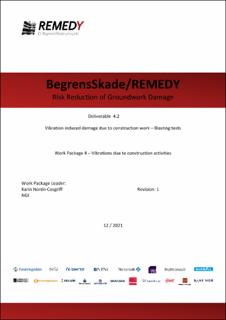| dc.contributor.author | Norén-Cosgriff, Karin | |
| dc.coverage.spatial | Norway | en_US |
| dc.date.accessioned | 2024-01-07T16:17:03Z | |
| dc.date.available | 2024-01-07T16:17:03Z | |
| dc.date.issued | 2021-12-01 | |
| dc.identifier.uri | https://hdl.handle.net/11250/3110274 | |
| dc.description.abstract | In this study, two instrumented blast test series were performed in a rock quarry in Norway. For the first test series, two buildings were erected, one made of Light Expanded Clay Aggregate (Leca) blocks, and one in cast-in-place unreinforced concrete. Both buildings were founded on a thin compacted gravel layer over rock. In the second test series one building made of Leca blocks was erected on top of an about 4 m thick filling, established at the same location as the buildings in the first test series. The test buildings were instrumented with triaxial geophones, accelerometers and Fiber Bragg Grating Sensors (strain sensors) in multiple positions. To gain full control, repeatability and traceability of the blasts, packaged emulsion and NG-based explosives
together with electronic detonators were used. | en_US |
| dc.language.iso | eng | en_US |
| dc.publisher | NGI - Norges Geotekniske Institutt | en_US |
| dc.relation.ispartofseries | NGI-rapport;20170774-D4.2 | |
| dc.title | Vibration induced damage due to construction work – Blasting tests | en_US |
| dc.type | Research report | en_US |
| dc.source.pagenumber | 52 | en_US |
| dc.relation.project | Norges forskningsråd: 267674 | en_US |
| dc.relation.project | BegrensSkade / REMEDY | en_US |
| dc.relation.project | Risk Reduction of Groundwork Damage | en_US |
